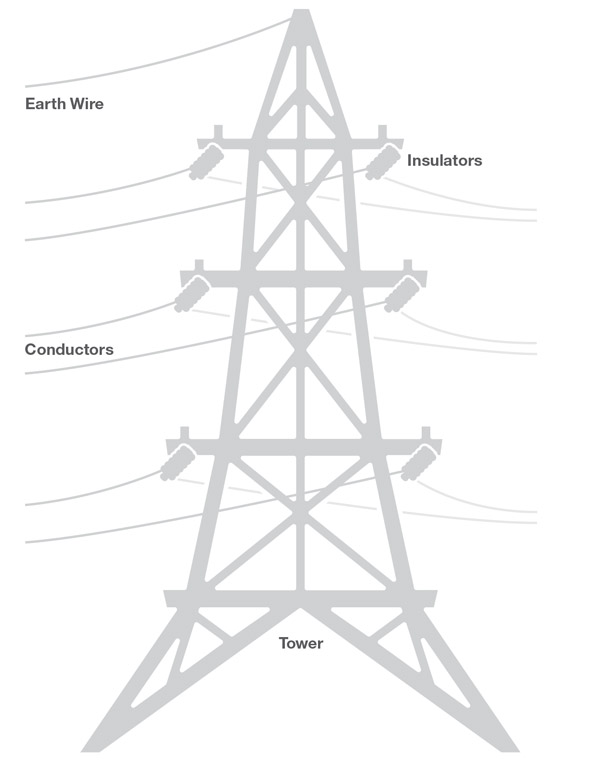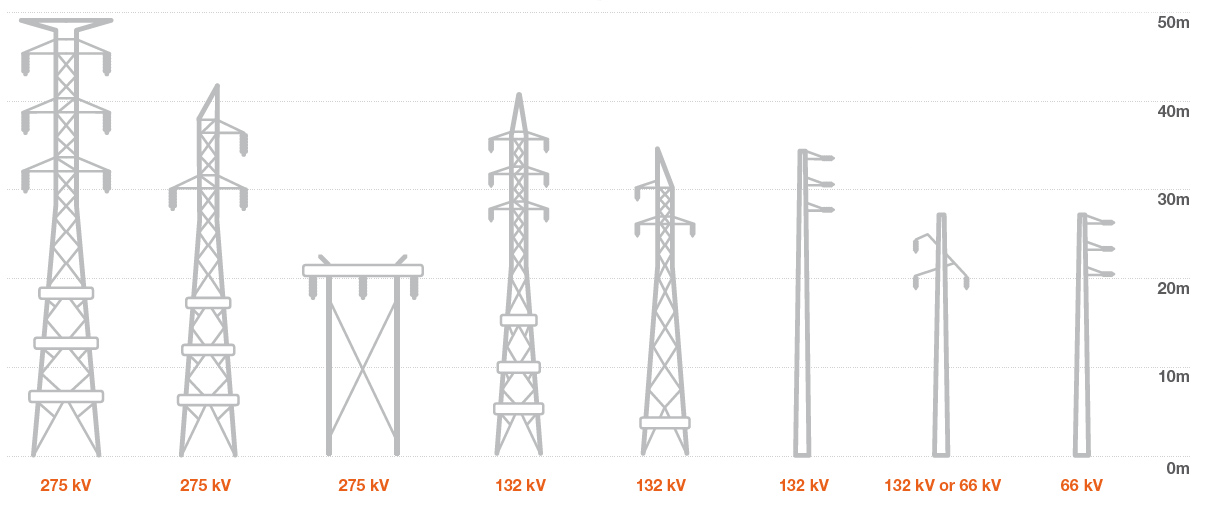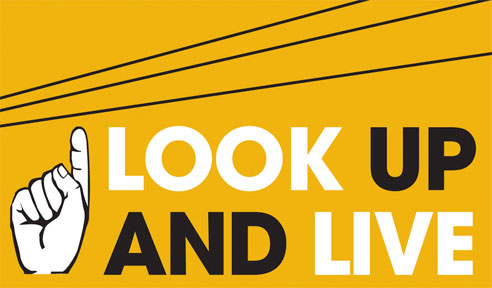Transmission Lines
ElectraNet owns and operates high-voltage transmission lines and cables that transport electricity over long distances to where it is needed.
We own and operate over 5,600 circuit kilometres of transmission line that operate at voltages of 275, 132 and 66 kilovolts (275,000, 132,000 and 66,000 Volts).
We also operate some underground transmission cables in metropolitan Adelaide that supply high-voltage power to the City of Adelaide.
Transmission Corridors
Transmission lines, and the corridors they’re found in, are generally made up of some common things.
Some of the components of a transmission corridor include the following:
- Towers or poles – usually made from steel and concrete, and positioned to ensure that conductors are out of reach. You can see some of the different types of towers or poles in the diagram below.
- Conductors or wires – typically made of aluminium alloy strands, these carry the electricity to the towers and are attached with insulators. Towers may also carry an earth wire to reduce the likelihood of direct lightning strikes.
- Insulators – Made from glass, porcelain or composite materials, insulators prevent the transfer of electricity to the tower or pole.
- Easements – registered agreements that allow ElectraNet rights of access and may restrict activities that a landowner or occupier can conduct within the easement area to ensure the safe operation and maintenance of the line.

Structure Types and Voltages
Overhead transmission lines are supported by a number of unique structure types, including steel lattice towers and masts. There are also several different pole designs, including a super-sized version of the well-known concrete and steel Stobie pole.

Safety around transmission lines
Coming into contact with or getting close to high-voltage transmission lines and cables can be extremely dangerous. To stay safe, if you are working and operating close to powerlines and cables, you will need to observe minimum clearance distances. The Government of South Australia has provided detailed information on working safely around powerlines.
If you are doing work with the potential to breach minimum clearance distances to high-voltage powerlines, you must inform ElectraNet’s System Control Centre in advance on 1800 243 853 (toll-free).
For further information on minimum clearance distances, please email Easement Enquiries.
If you are in any doubt about the operating distances near transmission lines, we can provide you with plans and other assistance to help prevent damage and personal injury.
If you see powerlines that look like they are close to the ground or if you are aware of changed circumstances (e.g. raised ground, new buildings constructed, new fences erected, new swimming pools etc) near powerlines, it is important that you report it to ElectraNet immediately on 1800 243 853 (toll free) or +61 8 8404 7966.
As with overhead powerlines, working near underground cables or coming into contact with them can result in serious injury.
If you are a private contractor, local government representative, or any other organisation or interested party undertaking development or digging works in South Australia, your first point of contact should be Dial Before You Dig. They provide the details of any underground asset, including ElectraNet’s high-voltage and fibre-optic underground cables.
You can find additional information on underground cable clearances on the Department of Planning, Transport and Infrastructure’s (DPTI) website.
Electric and magnetic fields (EMFs) are invisible fields produced by the generation, transmission, distribution and use of electrical power, including electricity travelling through powerlines.
We are guided in our management of electric and magnetic fields by research in the field on the matter. There are many independent authoritative scientific and medical reviews that have been published world-wide. After evaluating the research, none of these reviews conclude that electric and magnetic fields cause or contribute to adverse health effects.
However, ElectraNet continues to monitor all aspects of research into the EMF debate. We adopt best-industry practice in the planning and development of new electrical assets for our high-voltage transmission network by choosing solutions that minimise the potential risk to communities.
For more information on electric and magnetic fields, please refer to the Australian Radiation Protection and Nuclear Safety Agency and the World Health Organisation websites.
Landowners and occupiers should be aware that raising ground levels underneath powerlines to create a flat surface will further reduce minimum clearance distances. This activity is prohibited by law. The construction of any permanent structure near powerlines is also prohibited, including but not limited to sheds, silos, fences, swimming pools or loading-bays.
For more information, please view our Land Use Guidelines.
To minimise the risk of power outages, damage to powerlines or fire starts, ElectraNet does vegetation management works to make sure that legally required clearance distances between vegetation and powerlines are maintained.
We inspect and clear powerlines within a designated bushfire or high bushfire rated area every year, while lines in all other areas are inspected and cleared every three years.
Read more about the legal requirements for clearance distances from the Electricity (Principles of Vegetation Clearance) Regulations 2010. Further information is also available from our Vegetation Management factsheet.
Landowners or occupiers who contract low-flying aerial applicator services have a duty of care to provide pilots with a comprehensive map of the treatment area and property, including details of any powerline hazards. All powerlines on your property and within the treatment area must be displayed on the map with the voltage noted. Pilots need this essential information to develop their risk assessments and formulate a safe flight/work plan.
The Aerial Application Pilots’ Manual, published jointly by the Aerial Agricultural Association and the Civil Aviation Safety Authority, describes safety procedures for pilots of light aircraft working around powerlines.
Minimum working clearances are prescribed by law, depending on the type of activity being carried out. Road traffic rules stipulate a safety height limit for vehicles, including whip aerials, grain chutes and other vehicle extensions.

If your vehicle or an employee’s vehicle exceeds this limit when fully extended or if it is absolutely necessary for people to work near powerlines and/or on top of a vehicle, it is required by the Road Traffic Act that you first:
- obtain the necessary exemptions from the Road Transport Authority
- inform ElectraNet’s System Control Centre on 1800 243 853 (toll-free) to ensure the potential for electrocution is minimised.
ElectraNet has a small number of overhead high-voltage transmission lines that cross South Australian rivers and harbours.
Prior to transporting and sailing their recreational vessels, recreational and professional sailors should research the location of overhead powerlines and dismantle or lower masts where applicable.
Skippers of motorised vessels with large aerials and other protrusions should be mindful of overhead powerlines. The 4.6 metre maximum height limit applies when transporting boats on roads and into marinas, and when manoeuvring on boat ramps. Sailors must be familiar with the highest astrological tide and the Australian Height Datum (AHD) when calculating minimum clearance distances.
Contacting any powerline with any object is extremely dangerous and may result in serious injury. This includes contact with machinery or vessels, or extensions such as grain chutes, aerials, or flags on mastheads.
Remember to check for the location of overhead powerlines and potential electrical hazards, and be aware of working or undertaking leisure activities safely near overhead powerlines.
If the vehicle you are operating contacts a powerline, remain in the vehicle until the power is switched off and do not move around excessively. Use a mobile phone to make contact with others if possible.
It may become necessary to leave your vehicle. Only do this if:
- you are personally in danger of touching the powerline
- a fire starts
- it is unlikely that anyone else will know of your situation

If it becomes necessary to leave your vehicle, the following steps must be followed to maximise your safety:
- Do not climb on top of the vehicle.
- When leaving the vehicle, do not touch both the vehicle and the ground at the same time.
- Jump off the vehicle so that no part of your body (like your hand) is still touching the vehicle when any part of your body (like your foot) touches the ground.
- Land on your feet without your hands touching the ground.
- Calmly walk away from the vehicle with small steps.
- Once you leave the vehicle, do not return until you are absolutely certain the power has been switched off.
Make sure you keep others away from the vehicle. Bystanders should not approach or touch the vehicle or anyone on it until they are absolutely certain the power has been switched off. Emergency Services (Telephone: 000) should be advised of the incident as soon as possible.
Downloads
Visit our Resource Centre for more factsheets and reports of interest to landholders and the community.

